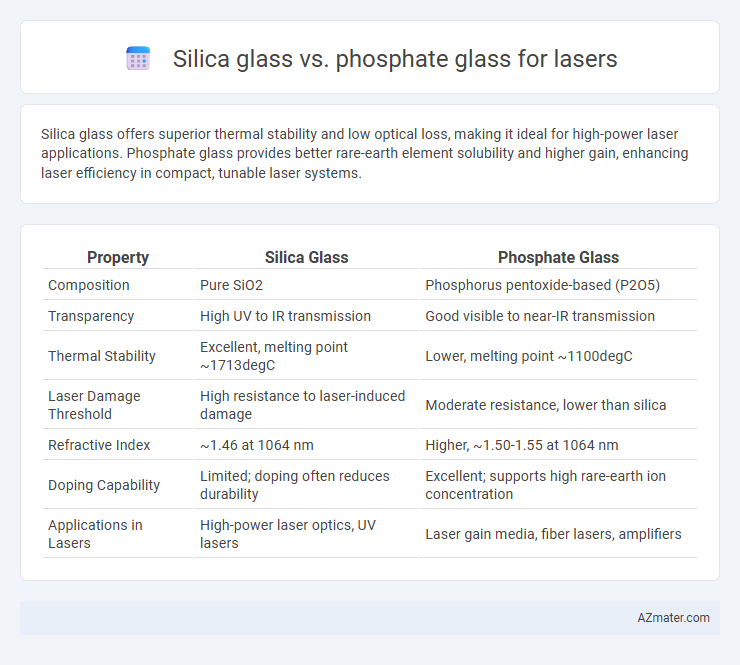Silica glass offers superior thermal stability and low optical loss, making it ideal for high-power laser applications. Phosphate glass provides better rare-earth element solubility and higher gain, enhancing laser efficiency in compact, tunable laser systems.
Table of Comparison
| Property | Silica Glass | Phosphate Glass |
|---|---|---|
| Composition | Pure SiO2 | Phosphorus pentoxide-based (P2O5) |
| Transparency | High UV to IR transmission | Good visible to near-IR transmission |
| Thermal Stability | Excellent, melting point ~1713degC | Lower, melting point ~1100degC |
| Laser Damage Threshold | High resistance to laser-induced damage | Moderate resistance, lower than silica |
| Refractive Index | ~1.46 at 1064 nm | Higher, ~1.50-1.55 at 1064 nm |
| Doping Capability | Limited; doping often reduces durability | Excellent; supports high rare-earth ion concentration |
| Applications in Lasers | High-power laser optics, UV lasers | Laser gain media, fiber lasers, amplifiers |
Introduction to Laser Glass Materials
Silica glass, primarily composed of silicon dioxide, offers exceptional thermal stability and low optical loss, making it a preferred material for high-power laser applications. Phosphate glass, rich in phosphorus pentoxide, provides higher rare-earth ion solubility and broader fluorescence bandwidth, which enhances laser efficiency and tunability. The choice between silica and phosphate glass depends on the desired laser performance parameters such as output power, wavelength range, and thermal management capabilities.
Understanding Silica Glass: Composition and Properties
Silica glass, primarily composed of silicon dioxide (SiO2), exhibits exceptional optical transparency and a high melting point around 1713degC, making it ideal for laser applications requiring stability under intense thermal conditions. Its low thermal expansion coefficient and high laser-induced damage threshold ensure efficient performance and longevity in high-power laser systems. Compared to phosphate glass, silica glass offers superior chemical durability and resistance to radiation, enhancing its reliability in demanding laser environments.
Phosphate Glass: Structure and Characteristics
Phosphate glass features a unique network of phosphorus-oxygen tetrahedra, offering higher rare-earth ion solubility and superior gain characteristics compared to silica glass. Its low melting temperature and high thermal expansion coefficient enable efficient doping and improved laser performance in high-power applications. The glass's enhanced fluorescence lifetime and broader emission spectra make it ideal for tunable and ultrafast laser systems.
Optical Performance Comparison: Silica vs Phosphate
Silica glass demonstrates superior optical clarity and higher damage thresholds compared to phosphate glass, making it ideal for high-power laser applications. Phosphate glass offers a broader transmission window and enhanced rare-earth ion solubility, which benefits tunable laser wavelength performance but with lower mechanical strength. The choice between silica and phosphate glass hinges on balancing optical durability and spectral versatility for specific laser system requirements.
Laser Damage Threshold: Which Glass Excels?
Silica glass exhibits a significantly higher laser damage threshold compared to phosphate glass, making it the preferred material for high-power laser applications where durability and resistance to laser-induced damage are critical. The intrinsic material properties of silica glass provide excellent thermal stability and low absorption, enabling it to withstand intense laser pulses without degradation. In contrast, phosphate glass, although valuable for its superior rare-earth ion doping capabilities and broader emission spectra, generally shows lower laser damage resistance, limiting its use in ultra-high-power laser systems.
Rare-Earth Doping Efficiency in Silica and Phosphate Glass
Rare-earth doping efficiency in silica glass is generally lower due to its rigid silica network, which leads to clustering and quenching effects of dopants like erbium or neodymium, reducing laser performance. Phosphate glass, with a more flexible phosphate network, supports higher rare-earth ion solubility and uniform distribution, resulting in enhanced luminescence efficiency and better laser gain properties. Consequently, phosphate glass is often preferred for high-power laser applications requiring intense rare-earth doping and efficient light amplification.
Spectral Broadening and Tunability for Lasers
Silica glass exhibits superior spectral broadening due to its low phonon energy and high optical damage threshold, enabling efficient ultrafast pulse generation across a broad wavelength range. Phosphate glass offers enhanced tunability and higher rare-earth ion solubility, facilitating broader laser emission bandwidths and improved gain for tunable laser systems. The combination of silica's robustness and phosphate's spectral flexibility makes them critical materials tailored to different laser applications requiring wide tunability and spectral control.
Thermal and Mechanical Stability Analysis
Silica glass exhibits superior thermal stability with a high melting point around 1713degC and a low thermal expansion coefficient (~5.5 x 10-7 /degC), making it ideal for high-power laser applications requiring minimal thermal distortion. Phosphate glass, while offering excellent laser gain and doping capabilities, has lower thermal stability due to a melting point near 1200degC and higher thermal expansion (~1.0 x 10-5 /degC), which can lead to increased thermal stress under high-energy laser operation. Mechanical stability of silica glass surpasses phosphate glass, demonstrating higher Young's modulus and fracture toughness, resulting in better resistance to cracking and deformation during laser-induced thermal cycling.
Cost and Manufacturing Considerations
Silica glass offers superior thermal stability and lower optical losses, making it ideal for high-power laser applications, but its manufacturing involves higher energy consumption and costly purification processes. Phosphate glass, while generally cheaper and easier to produce with diverse dopant incorporation, exhibits lower damage thresholds and reduced durability under intense laser operation. Cost efficiency favors phosphate glass in low to mid-power lasers, whereas silica glass justifies its premium price for high-performance and long-lifespan laser systems.
Best Applications: Choosing the Right Glass for Your Laser
Silica glass offers exceptional thermal and chemical stability, making it ideal for high-power laser systems used in industrial cutting, medical surgery, and scientific research where durability and precision are critical. Phosphate glass provides superior rare-earth ion solubility and efficient laser emission, favoring applications in tunable lasers, fiber lasers, and laser amplifiers requiring high gain and broad bandwidth. Selecting the right glass depends on the laser's operational power, wavelength range, and application-specific performance demands.

Infographic: Silica glass vs Phosphate glass for Laser
 azmater.com
azmater.com